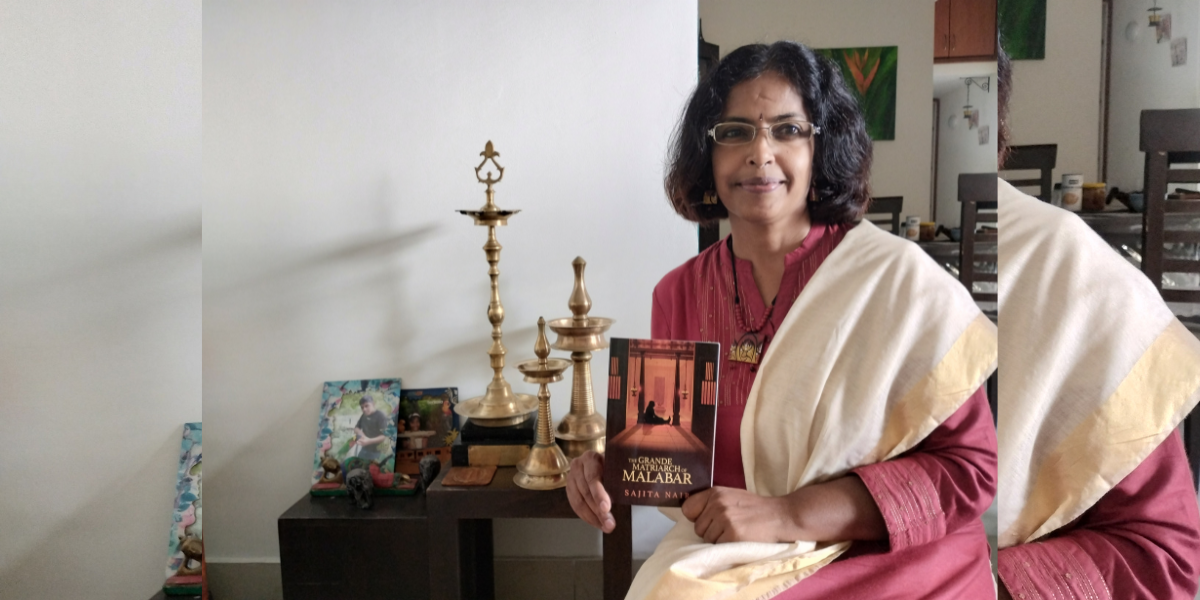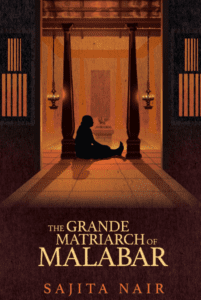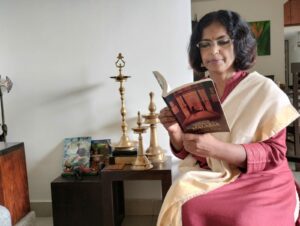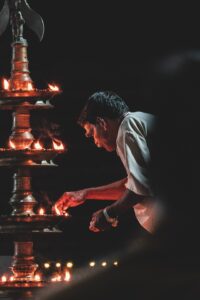Sajita Nair’s book promises to take you back to a time in Kerala when traditions and family values dictated the course of life.

Sajita Nair's latest book is a clarion call for Malayalis to reconnect with their roots. (Marina Paulose/South First)
I am fiercely connected to my family and my Malayali roots, and I can say this with confidence. But after reading Sajita Nair’s new book, I have come to the conclusion that I am painfully unaware of my ancestors, and I need to know more about my family’s history.
We live in an era where the nuclear family system is all the rage. Nair’s latest work The Grande Matriarch of Malabar makes one wonder about the period when the very concept of living without your elders in the same household was an inconceivable idea. The book promises to take you back to a time in Kerala when traditions and family values dictated the course of your life.

Nair’s book is a stroll through Kerala’s once-prized traditions. (Supplied)
The Marumakkathayam, living in a traditional naalukettu, the endless rituals and age-old traditions, the glories of tharavads, and practices on the verge of turning obsolete — are all slathered with liberal doses of rich, ghee-filled payasam in the book.
A stubborn matriarch, full of pride, who is waging a war against time and her family to continue her proud lineage is the central figure. She is one of the most complex characters I have ever read. She evokes a complicated bunch of feelings — from a hint of admiration and often envy to downright loathing and pure rage.
What takes precedence in the book is the concept of Marumakkathayam — where the descent and inheritance of property were traced through women.
In a society where patriarchy is the norm, reading about a mother taking the world on her shoulders to ensure her daughter continues her legacy is a refreshing one.
After having devoured the book in just a couple of days, I sat down with Nair for an exclusive chat for South First to get an insight into her book.
Q. The concept of a matrilineal household has not been explored much.

Kerala’s traditional naalukettu style of house is described in great detail in the book. (Flickr/Gopal Vijayaraghavan)
A. After I finished my first book, She’s a Jolly Good Fellow in 2010, which is based on my experiences in the Indian Army, the next idea that came to my mind was to write about a tharavad.
Having lived a tharavad life, I know what it is. Looking around, I found that all tharavads are fading away. This idea occurred to me somewhere around 2011, and I had been working on it since then.
In the book, we have an inanimate narrator talking about how it feels to live in a tharavad, and takes us through the family’s evolution over time while battling to stay connected to its roots.
Q. Is there any personal influence in book?
A. I have seen the powerful affection a mother can have for her daughter, in a tharavad. That was a great influence on me when I was creating the characters. The main character in the book is obstinately obsessed with continuing her legacy and lineage. I have witnessed it.
My father used to tell me a lot of stories from his younger days, some of those anecdotes have also made their way into the book.
Q. Do you think the concept of Marumakkathayam still exists in Malayali families?

Nair’s father told her several anecdotes from his childhood which have made their way into her book. (Marina Paulose/South First)
A. No, I don’t think so. In today’s world, it’s neither matriliny nor patriliny. As we live in nuclear families, members are attaining equal status.
Hierarchy is disappearing and everyone has equal opportunity irrespective of gender or age, in most urban families.
In my case, I have a brother, and my parents always treated us equally in every manner, even property.
The concept of women being preferred over men, or the preference of a male successor in certain parts of North India doesn’t really exist anymore in today’s time.
Q. Do you think the central character, Dakshayani Amma, comes across as inspiring enough for women, given some of the questionable decisions she makes, and her treatment of other women in the household?

Liberal doses of Malayali culture, traditions & ancient family values make this book an illuminating read. (Unsplash/Sanjay Ajayan)
A. The story is set in the 50s and 60s. She is a powerful and ambitious woman, who single-handedly plans the future of her household.
Amma may not prioritise empowering other women in the family, because that’s how her life has always been. She was also financially stable in certain ways since she ran her own estates.
It’s debatable if she comes across as inspiring or not, but from her point of view, every step she took was right. Someone else might not feel so because she put so many lives at stake for her own cause.
Also, when I was creating this character, my intention was not to make her an inspiring figure. I wanted to show a powerful woman, witnessing everything around her changing, and how she fights through it.
I have shown about five decades in the book, and all through that, she does not really evolve.
Q. Would male readers be taken aback by Dakshayani Amma? A strong woman trampling over most male members in the family, including her son, for the sake of her daughter.
A. Once again, the time the story is set in comes into fray. The time in which Dakshayani Amma is the head of the household was a time in Kerala when a woman ran the whole show.
It was an accepted norm then and even the men in the family, at the time, made their peace with it. Men who read this book should see it as just another type of system created to run a family, which did exist at one point.
Q. Did you have a particular goal in mind while writing this book?
A. I wanted to highlight the importance of preserving our heritage. These days we see nationalism on the rise, and we are more proud than ever of being Indians. In a similar manner, we should also be proud of our roots and who we are and hail our culture.

May 03, 2024

May 03, 2024

May 03, 2024

May 02, 2024

May 02, 2024

May 02, 2024